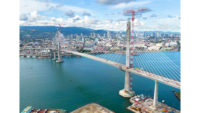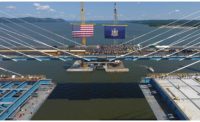Marking another milestone in India's burgeoning infrastructure expansion, the $2.15-billion, six-lane, 22-km Mumbai Trans Harbour Link (MTHL) between the island city of Mumbai and its satellite city of Navi Mumbai on the mainland, was inaugurated by Prime Minister Narendra Modi on Jan 12. Carrying an estimated 70,000 vehicles daily, it will enable faster connectivity, reduce congestion and emissions in Mumbai and connect to the rapidly developing Navi Mumbai and its new international airport.
The MTHL, also known as the Sewri–Nhava Sheva Trans Harbour Link, has been officially named Atal Bihari Vajpayee Trans Harbour Link, after a former Prime Minister. It is the longest sea crossing in India, connecting interchanges at both ends with approach roads, and viaducts in an intertidal zone.
 Japan helped fund and build India's longest roadway over water.
Japan helped fund and build India's longest roadway over water.Photo courtesy of MTHL
Mumbai Metropolitan Region Development Authority (MMRDA) had appointed AECOM Asia Co Ltd as the lead in a consortium with PADECO Co. Ltd., Dar AI-Handasah Consultants, a TY Lin International-led consortium as the general consultant and STUP leading design consultants. The project utilized an Engineering, Procurement and Construction (EPC) delivery method with an Official Development Assistance loan from the Japan International Cooperation Agency (JICA). Construction began in 2018.
The length of MTHL over water is 16.5 km and 5.5 km on land. The first contract, for intertidal and marine construction comprising 10.38 km was awarded to Larsen and Toubro and Japan's IHI Corp consortium. The second contract for marine construction of 7.8 km went to Korean Daewoo E&C in a joint venture with Tata Projects Ltd, a construction subsidiary of the Tata Group. The 3.6-km third contract for land roadwork is held by Tata Projects.
Corrosion-resistant materials were used to withstand weather conditions such as high wind speeds and tides, along with earthquakes up to 6.5 magnitude and cyclones. Around 1,100 lighting poles coated with a corrosion-free polyurethane coating are equipped with a central control and monitoring system.
Seventy spans of the link, for about 6.4 km, are comprised of orthotropic steel decks using Japanese technology. The width of the steel superstructure is about 14.92 m for each carriageway. According to JICA, orthotropic steel decks are lighter but stronger than concrete or composite girder bridges, requiring fewer and smaller piers. IHI Corp utilized its group factories, mainly in Japan and Vietnam for fabrication.
The deck segments were separated into six to eight blocks and delivered to the site in 33 shipments by sea. These blocks were assembled at the site into erection units, as long as 180 m and as heavy as around 2,600 metric tons, and moved on self-propelled modular transporters to the temporary jetty. The orthotropic steel decks were loaded onto a special barge equipped with lifting towers with 16 strand jacks and lifted onto the piers. The barge was towed to the assembly location, according to JICA.
A senior JICA official stated when the segments were being erected: "I strongly hope that some of the approaches and innovative technologies, adopted under MTHL become models of excellence, which could be replicated in other infrastructure projects in India."
Mumbai has only 2,000 km of road compared to Delhi’s 29,000 km. With increasing congestion, the Maharashtra government is focusing on building metro rail corridors as well as roadwork.
Three megaprojects—Mumbai Metro Line 3, the Navi Mumbai Airport and the Mumbai Coastal Road—are also expected to start operations this year.
Mumbai’s population is projected to more than double in coming decades, reaching 42 million by 2060. AECOM India CEO Avinash Misra said at an industry forum: “An integrated approach to land planning in Mumbai may serve as an example for other rapidly growing cities ... with holistic transportation planning, including metro, transit-oriented development and strategic road improvements, Mumbai can ensure that it makes the best use of its land today and tomorrow.”




Post a comment to this article
Report Abusive Comment